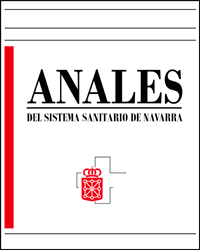Circuit life span of continuous renal replacement therapy in critically ill patients with or without conventional anticoagulation: an observational prospective study
DOI:
https://doi.org/10.23938/ASSN.0008Keywords:
Anticoagulation. Critical patients. Extrarenal depuration techniques. Heparin. Saline solution.Abstract
Background. The aim of this study was to describe the efficacy, security and viability of an anticoagulation system with continuous infusion of unfractionated heparin (UFH) versus one without any type of anticoagulant using 0.9% physiological saline washings, in critically ill patients with continuous renal replacement therapy (CRRT) and different risks of bleeding.
Methods. From October 2013 to April 2015 we conducted an observational prospective study in the intensive care unit (ICU). Sixty-one patients with acute kidney injury (AKI) and requiring CRRT were included, with 122 filters. Patients and filters were divided in two groups: anticoagulated (AC) and not anticoagulated (No AC). The main outcome measure was filter life span. Different analytical parameters were also collected at the beginning of treatment and at the moment of circuit coagulation
Results. The number of patients was similar in both groups. We did not find statistically significant differences between the two groups in filter life span (30.5 hours AC vs 34.9 hours No AC). Patients with increased morbidity (severe thrombocytopenia, coagulopathy, etc.) were included in the group that did not received anticoagulation but saline flushes.
Conclusions. CRRT without anticoagulation with saline flushes is a viable, safe and effective strategy in critically ill patients with high risk of bleeding. This approach achieves a circuit life span similar to that observed in anticoagulated patients with UFH; avoiding the risks and costs associated with anticoagulation.
Downloads
References
DENNEN P, DOUGLAS IS, ANDERSON R. Acute kidney injury in the intensive care unit: an update and primer for the intensivist. Crit Care Med 2010; 38: 261-275.
TOLWANI A. Continuous renal-replacement therapy for acute kidney injury. N Engl J Med 2012 27; 367: 2505-2514.
UCHINO S, KELLUM JA, BELLOMO R, DOIG GS, MORIMATSU H, MORGERA S et al. Acute renal failure in critically ill patients: a multinational, multicenter study. JAMA 2005 17; 294: 813-818.
Kidney Disease Outcomes Quality Initiative. KDIGO Clinical Practice Guidelines for Acute Kidney Injury. Kidney Int Suppl 2012; 2: 1-138.
JOANNIDIS M, OUDEMANS-VAN STRAATEN HM. Clinical review: patency of the circuit in continuous renal replacement therapy. Crit Care 2007; 11: 218.
UCHINO S, BELLOMO R, MORIMATSU H, MORGERA S, SCHETZ M, TAN I et al. Continuous renal replacement therapy: a worldwide practice survey. The beginning and ending supportive therapy for the kidney (B.E.S.T. kidney) investigators. Intensive Care Med 2007; 33: 1563-1570.
OUDEMANS-VAN STRAATEN HM, KELLUM JA, BELLOMO R. Clinical review: anticoagulation for continuous renal replacement therapy--heparin or citrate? Crit Care 2011 24; 15: 202.
STUCKER F, PONTE B, TATAW J, MARTIN PY, WOZNIAK H, PUGIN J et al. Efficacy and safety of citrate-based anticoagulation compared to heparin in patients with acute kidney injury requiring continuous renal replacement therapy: a randomized controlled trial. Crit Care 2015 18; 19: 91-015-0822-z.
UCHINO S, FEALY N, BALDWIN I, MORIMATSU H, BELLOMO R. Continuous venovenous hemofiltration without anticoagulation. ASAIO J 2004; 50: 76-80.
ZIMBUDZI E. Intermittent saline flushes or continuous saline infusion: what works better when heparin-free dialysis is recommended? Int J Nephrol Renovasc Dis 2013 15; 6: 65-69.
KARAKALA N, TOLWANI A. We use heparin as the anticoagulant for CRRT. Semin Dial 2016; 29: 272-274.
NAGARIK AP, SONI SS, ADIKEY GK, RAMAN A. Comparative study of anticoagulation versus saline flushes in continuous renal replacement therapy. Saudi J Kidney Dis Transpl 2010; 21: 478-483.
RICCI Z, RONCO C, BACHETONI A, D'AMICO G, ROSSI S, ALESSANDRI E et al. Solute removal during continuous renal replacement therapy in critically ill patients: convection versus diffusion. Crit Care 2006; 10: R67.
TAN HK, BALDWIN I, BELLOMO R. Continuous veno-venous hemofiltration without anticoagulation in high-risk patients. Intensive Care Med 2000; 26: 1652-1657.
SLOWINSKI T, MORGERA S, JOANNIDIS M, HENNEBERG T, STOCKER R, HELSET E et al. Safety and efficacy of regional citrate anticoagulation in continuous venovenous hemodialysis in the presence of liver failure: the Liver Citrate Anticoagulation Threshold (L-CAT) observational study. Crit Care 2015 29; 19: 349-015-1066-7.
Downloads
Additional Files
Published
How to Cite
Issue
Section
License
Copyright (c) 2017 Anales del Sistema Sanitario de Navarra

This work is licensed under a Creative Commons Attribution-ShareAlike 4.0 International License.
La revista Anales del Sistema Sanitario de Navarra es publicada por el Departamento de Salud del Gobierno de Navarra (España), quien conserva los derechos patrimoniales (copyright ) sobre el artículo publicado y favorece y permite la difusión del mismo bajo licencia Creative Commons Reconocimiento-CompartirIgual 4.0 Internacional (CC BY-SA 4.0). Esta licencia permite copiar, usar, difundir, transmitir y exponer públicamente el artículo, siempre que siempre que se cite la autoría y la publicación inicial en Anales del Sistema Sanitario de Navarra, y se distinga la existencia de esta licencia de uso.








